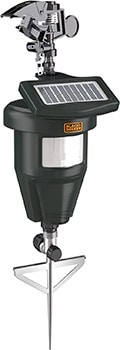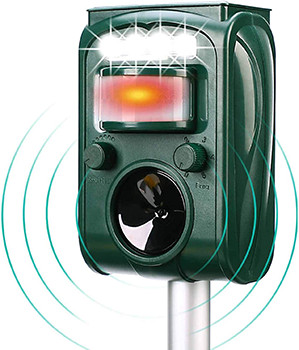How to Get Rid of a Skunk in Your Yard – 7 Expert Tips
-
Ed Malaker
- Last updated:

A frustrating experience for any homeowner is a skunk making itself at home on your property. If it’s hanging around your porch or garage, it could signify that it intends to stay a while and is setting up a home. If this sounds like your situation, keep reading as we list several tips and tricks that you can try to help convince the intruder to find somewhere else to go before it causes big problems for you or your pets.
The 7 Tips to Get Rid of a Skunk in Your Yard
1. Motion-Sensing Sprinklers
Skunks are easily startled and like to keep things peaceful and quiet, which makes a motion-sensing sprinkler system a great option for getting rid of them. These systems are usually reasonably priced and easy to set up. They will quickly convince the skunk to go elsewhere—as long as it can’t find shelter—and the water will also help keep other critters off your property while promoting a greener lawn
The downside of a motion-sensing sprinkler is that you will need to pay for the water that it sprays, which can add up, especially if several animals constantly enter your yard, causing it to turn on frequently. You will also be spraying a large amount of water at night, since that is when many skunks are active, and this can invite snails into your yard, which can cause damage to your garden and decorative plants and shrubs.
- Affordable
- Effective
- Easy to set up
- Might invite snails
- Water costs
2. Motion-Sensing Lights

While not as effective as motion-sensing sprinklers due to the skunk’s poor eyesight, motion-sensing light can convince a skunk to move on to another location, especially if it feels exposed. Motion-sensing lights are usually not that expensive, are easy to set up, and can help scare away other animals and even intruders that might be wandering onto your property.
The downside to motion-sensing lights is that the skunk might not notice them turn on and continue scrounging around your property. Your electric bill might also go up if the light comes on frequently, especially if you use powerful bulbs.
- Inexpensive
- Easy to set up
- Might scare away other animals and intruders
- Higher electric costs if the light turns on frequently
- Might not be as effective as some other options on this list
3. Ultrasonic Devices
Another commercial product that you can purchase to help keep skunks out of your yard is an ultrasonic repellant device. It will produce a loud ultrasonic noise that will cause a skunk and many other animals to run away, but it’s completely silent to humans, similar to an electronic dog whistle. This device is fairly inexpensive and easy to set up; place it in your yard where you usually see the skunk, and it will turn on automatically when the animal gets close.
The downside to ultrasonic devices is that you can’t hear them, so you have no way of knowing how loud the device is or even if it works. When it does work, it will affect many other animals besides skunks, including cats, dogs, deer, and raccoons. If the sound is too loud, it can cause harm or even damage the animal’s hearing. It can also anger neighbors with pets if they start to react to the device.
- Inexpensive
- Easy set-up
- Works on many animals
- No way to know how well it works
- Might cause harm to neighborhood cats and dogs
4. DIY Repellant

A DIY repellant can be a great option for convincing a skunk to move on without wasting water or bothering neighborhood pets. Mixing a few common ingredients can create a fragrance that even skunks won’t like. Fill a pot with water, and add onions, jalapeño peppers, and cayenne pepper powder. Boil the mixture for 1/2 an hour before straining it into a spray bottle. Then, spray liberally around your property where you usually see the skunk, to drive it off. The more onions and peppers you boil, the more effective it will be.
The downside to DIY repellants is that you need to keep reapplying them to be effective, as rain and even dew can dilute and wash away the solution, making it less effective. You will also need to frequently make more of it, which can be a hassle.
- Easy to make
- Inexpensive
- Easy to use
- Need to reapply frequently
- Might require many batches
5. Citrus Trees

One fragrance that skunks hate is citrus. If you live where oranges, lemons, or other citrus fruit can grow, planting a few trees on your property can effectively deter skunks, and you will have tasty fruit that you can enjoy year after year.
The downside to planting citrus trees as a skunk deterrent is that it can take several years before the plant establishes itself enough to produce the fruit that keeps the skunks away, so it won’t help you with any problems that you currently have.
- Inexpensive
- Effective
- Produces tasty fruit
- Can take years to become effective
6. Live Traps

Live traps are ideal for getting rid of a skunk quickly without hurting the animal or getting sprayed. These traps enable you to catch the skunk using bait, so you can transport it to another location to set it free. They work well and will keep the animal safe and secure until you release it. You can also reuse them to catch other animals entering your yard.
The downside of a live trap is that it can be quite expensive, and you might only get one use out of it. Also, some people are uneasy about transporting a live animal, especially a skunk. Another problem with live traps is that you must check them frequently so the trapped animals don’t suffer.
- Quickly removes the skunk
- Effective
- Can work on other animals
- Expensive
- You will need to transport and release the skunk
- Require frequent checking
7. Animal Control

You can call your local animal control for help if the previous methods are ineffective or unsuitable. Animal control will send qualified technicians to capture and remove the skunk quickly. You won’t need to do anything but pay a fee, so it can be a great solution for properties that you don’t visit often.
The downside to calling animal control is that it can be quite expensive, and if the facility is busy, it can be several days before technicians arrive to remove the skunk.
- Easiest option
- Qualified technicians can catch and remove the skunk quickly
- Expensive
Consult a PEST-CONTROL expert
Find a pest-control specialist in your area, and get free, no-commitment estimates for your project.

Other Tips and Tricks That Will Help Keep Skunks Away
- Keep lids on all your garbage cans and seal them tightly every night.
- Feed your pets indoors so skunks can’t smell their food and get curious.
- Remove any backyard bird feeders or clean up any seeds that fall to the ground, as these will attract skunks.
- If you don’t have bird feeders or open garbage, skunks might be feeding off grubs in your yard, so treating the lawn each spring can help remove this food source.
- Keep skunks out of small areas like your porch by enclosing them with chicken wire.

 Conclusion
Conclusion
If you have a skunk visiting your yard every night, a motion-activated sprinkler system can help convince it to move to another location. Skunks don’t like to be wet, nor do they appreciate the surprise of water suddenly spraying them or the noise of the sprinkler. Motion-sensing lights and ultrasonic devices can also work, as can DIY repellent if you don’t mind making a new batch every day or two. If you live near a wooded area, you can use a live trap to catch and release it or call animal control and have them take care of the problem for a small fee.
Featured Image Credit: Jumpstory
Contents


